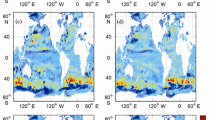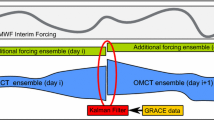Abstract
A new data assimilation algorithm (Quasi-EnKF) in ocean modeling, based on the Ensemble Kalman Filter scheme, is proposed in this paper. This algorithm assimilates not only surface measurements (sea surface height), but also deep (∼2000 m) temperature observations from the Gulf of Mexico into regional ocean models. With the use of the Princeton Ocean Model (POM), integrated for approximately two years by assimilating both surface and deep observations, this new algorithm was compared to an existing assimilation algorithm (Mellor-Ezer Scheme) at different resolutions. The results show that, by comparing the observations, the new algorithm outperforms the existing one.
Similar content being viewed by others
References
Berntsen J, Oey L Y (2010). Estimation of the internal pressure gradient in σ-coordinate ocean models: Comparison of second-, fourth-, and sixth-order schemes. Ocean Dyn, 60(2): 317–330
Chassignet E P, Hurlburt H E, Smedstad O M, Barron C N, Ko D S, Rhodes R C, Shriver J F., Wallcraft A J, Arnone R A (2005). Assessment of data assimilative ocean models in the Gulf of Mexico using ocean color. Geophysical Monograph—American Geophysical Union, 161: 87
Cooper M, Haines K (1996). Altimetric assimilation with water property conservation. J Geophys Res, 101(C1): 1059–1077
Craig P D, Banner M L (1994). Modeling wave-enhanced turbulence in the ocean surface layer. J Phys Oceanogr, 24(12): 2546–2559
Donohue K, Hamilton P, Leaman K, Leben R, Prater M, Watts D R, Waddell E (2006). Exploratory Study of Deepwater Currents in the Gulf of Mexico, Vol. I and II. US Dept. of the Interior, Minerals Management Service, Gulf of Mexico OCS Region, New Orleans, LA. OCS Study MMS, 2006-073
Evensen G (2003). The Ensemble Kalman Filter: theoretical formulation and practical implementation. Ocean Dyn, 53(4): 343–367
Ezer T, Arango H, Hermann A (2003). Terrain-Following Ocean Models Users Workshop, Seattle, WA, Aug. 4–6, AOS Program, Princeton University, 19
Ezer T, Mellor G L (1994). Continuous assimilation of Geosat altimeter data into a three-dimensional primitive equation Gulf Stream model. J Phys Oceanogr, 24(4): 832–847
Gaspari G, Cohn S E (1999). Construction of correlation function in two and three dimensions. Q J R Meteorol Soc, 125(554): 723–757
Kalnay E (2003). Atmospheric Modeling, Data Assimilation and Predictability. New York: Cambridge University Press, 341
Kantha L, Choi J K, Schaudt K J, Cooper C K (2005). A Regional Data-Assimilative Model for Operational Use in the Gulf of Mexico. Geophysical Monograph—American Geophysical Union, 161, 165
Lin X H, Oey L Y, Wang D P (2007). Altimetry and drifter data assimilations of Loop Current and eddies. J Geophys Res, 112(C5): C05046
MacKinnon J A, Gregg M C (2003). Shear and baroclinic energy flux on the summer New England Shelf. J Phys Oceanogr, 33(7): 1462–1475
Mellor G L (2001). One-dimensional ocean surface layer modeling, a problem and a solution. J Phys Oceanogr, 31(3): 790–809
Mellor G L (2004). User’s Guide for a Three-dimensional, Primitive Equation, Numerical Ocean Model. Program in Atmospheric and Oceanic Sciences, Princeton University, 42
Mellor G L, Ezer T (1991). A Gulf Stream model and an altimetry assimilation scheme. J Geophys Res, 96(C5): 8779–8795
Mellor G L, Yamada T (1982). Development of a turbulence closure model for geophysical fluid problems. Rev Geophys, 20(4): 851–875
Oey L Y (1995). Eddy- and wind-forced shelf circulation. J Geophys Res, 100(C5): 8621–8637
Oey L Y (1996a). Flow around a coastal bend: a model of the Santa Barbara Channel eddy. J Geophys Res, 101(C7): 16667–16682
Oey L Y (1996b). Simulation of mesoscale variability in the Gulf of Mexico: sensitivity studies, comparison with observations, and trapped wave propagation. J Phys Oceanogr, 26(2): 145–175
Oey L Y, Chen P (1992a). A model simulation of circulation in the Northeast Atlantic shelves and seas. J Geophys Res, 97(C12): 20087–20115
Oey L Y, Chen P (1992b). A nested-grid ocean model: with application to the simulation of meanders and eddies in the Norwegian Coastal Current. J Geophys Res, 97(C12): 20063–20086
Oey L Y, Lee H C, Schmitz W J (2003). Effects of winds and Caribbean eddies on the frequency of Loop Current eddy shedding: a numerical model study. Journal of Geophysical Research: Oceans (1978–2012), 108(C10)
Oey L, Ezer T, Lee H (2005). Loop Current, rings and related circulation in the Gulf of Mexico: a review of numerical models and future challenges. Geophysical Monograph—American Geophysical Union, 161, 31
Sturges W, Lugo-Fernandez A (2005). Circulation in the Gulf of Mexico: Observations and Models, Geophys. Monogr. Ser., Vol. 161. Washington, D C: AGU, 347
Wang D P, Oey L Y, Ezer T, Hamilton P (2003). Near-surface currents in DeSoto Canyon (1997–99): comparison of current meters, satellite observation and model simulation. J Phys Oceanogr, 33(1): 313–326
Yin X Q, Oey L Y (2007). Bred-ensemble ocean forecast of Loop Current and rings. Ocean Model, 17(4): 300–326
Author information
Authors and Affiliations
Corresponding author
Rights and permissions
About this article
Cite this article
Sun, Z., Oey, LY. & Zhou, YH. Skill-assessments of statistical and Ensemble Kalman Filter data assimilative analyses using surface and deep observations in the Gulf of Mexico. Front. Earth Sci. 7, 271–281 (2013). https://doi.org/10.1007/s11707-013-0377-8
Received:
Accepted:
Published:
Issue Date:
DOI: https://doi.org/10.1007/s11707-013-0377-8




